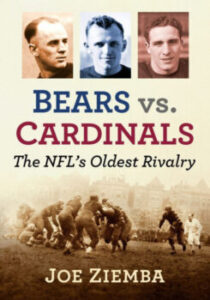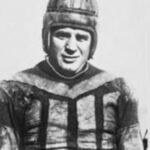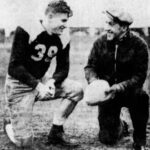One of the most important innovations in the history of the National Football League occurred in February of 1936 when the NFL initiated its very first draft of collegiate players. It was a revolutionary concept; each team, beginning with the one having the worst record to the best from the previous season, would be able to secure the sole rights to negotiate with a specific player that the team selected.
Bert Bell of the Philadelphia Eagles, who would later prove to be a visionary leader as the commissioner of the NFL, has been rightfully credited with the idea of instituting the draft. Perhaps not ironically, the Eagles also possessed the worst position in the standings from the 1935 season. Beginning in 1936, Bell’s brainchild would now override the usual wide-open recruitment of college athletes.
Previously, the top gridders would sign with the highest bidder, or perhaps one that offered the best chance of football success. Teams like the Bears and the Giants traditionally had helped themselves to the finest graduating seniors. The first NFL draft was staged in rather modest conditions in comparison with today’s multi-day extravaganza. Held at the Ritz-Carlton Hotel in Philadelphia on February 8, 1936, the draft lasted just nine rounds and was over in one day.
At the time, the league consisted of only nine teams and the team representatives helped compile a list of 90 names that were etched onto a blackboard in the meeting room. In other words, there was no scouting, no opulent entertainment of potential top picks, and no rude demands from glittering agents–just a small group of football executives hoping to improve their lot in life by selecting nine players that they may or may not have ever heard about!
First NFL Draft Pick Ever
Emerging as the top pick was a speedy halfback from the University of Chicago named Jay Berwanger. Born March 19, 1914, he was the son of a blacksmith in Dubuque, Iowa and the first winner in 1935 of what would become known as the Heisman Trophy. Berwanger never played football until he was an end at Jefferson Junior High School and Berwanger later told the Chicago Daily News: “I guess that was when I first began to get some idea of what real football is, but I didn’t really learn until I got into senior high school.”
While in high school in Dubuque, Berwanger switched from end to halfback and quickly impressed his coaches by scoring a touchdown as a sophomore against rival Cedar Rapids. Coach Wilbur Dazell saw the potential in the quick, 150 lb. back stating: “Here was a boy who, at 15, was a rarity of football, who could run as well to his left as he could to his right. A willing kid who could punt and pass, who could learn rapidly and who could run like the wind. Above all, here was a youngster who loved to play.” Berwanger improved each season, grew to 175 lbs. and led his team to the state title as a senior.
After high school, Berwanger was steered to the University of Chicago by former Maroon Ira Davenport, a 1912 graduate and then the president of the Dubuque Boat and Boiler Works. “I wanted to go to college,” said Berwanger. “Secondly, I wanted to play football. But I wanted to take my football at a school where I could balance it with some pretty serious work at the education business. That came first.” The Chicago Tribune later noted his arrival on campus: “Jay arrived in a cattle truck, smelling of hay and hogs, astonishing the members of his chosen fraternity!”
He arrived on the Chicago campus in the fall of 1932 which would prove to be the last season under legendary coach Amos Alonzo Stagg. Stagg was at Chicago from 1892 through 1932 and won two national championships. However, the glory years were well behind Stagg by the time Berwanger showed up. “It was his last year there,” recalled Berwanger to the Ft. Worth Star. “He was a fine person and a great coach. His teams had legendary battles with Fielding Yost’s teams at Michigan and he was winning championships when Knute Rockne was a child. In fact, when I was there, I think Chicago had still won more Big Ten titles than any other school. But they hadn’t won one in a while.”
Chicago's One-Man Team
His varsity football debut as a sophomore in 1933 was a scorcher, according to the Chicago Daily News, which said:
A flashing demon in an iron mask, he tore through and over and around the Cornell College line for four touchdowns, kicked two points after touchdown and brought the greatest joy of a decade to the faithful followers of the Maroons.
Berwanger was one of the first to use what we might call a face mask which he wore to protect a broken nose. Thus, the description of the “flying demon in the iron mask”! Wearing the unusual mask, he never did re-injure his nose.
With the Maroons, Berwanger was known as “Chicago’s one-man team.” He agreed with that assessment: “In those days, I played defense, did all the passing and punting, and a lot of the running. In my senior year, I also had to call the signals, because right before the season, our quarterback got married and quit school!” During his career at the University of Chicago, Berwanger picked up 1,839 yards on 439 carries for a 4.2 average. He completed 50 passes for 921 yards and scored 152 points on 22 touchdowns and 20 extra points. As a senior in 1935, he was clearly one of the top players in the country and the Chicago Tribune awarded him its silver football award, symbolic of the Most Valuable Player in the Big Ten.
But there was one more honor that found its way to Berwanger in late 1935. He received a telegram from the New York Athletic Club inviting him to New York to receive a trophy honoring him as the “most valuable player east of the Mississippi River.” A year later, the award was renamed as the Heisman Trophy, but Berwanger was the first to receive this revered honor. In 1985, he said: “It wasn’t really a big deal when I got it. I was more excited about the trip to New York than the trophy because it was my first airplane flight.” Many consider Berwanger to be the model for the current Heisman Trophy figurine.
In 1998, he provided some thoughts on that subject: “Well, I know it’s documented that they used some players in New York to pose for that trophy. I’ve always thought that it looks a lot like a picture that ran of me in the Dubuque paper one time. But I’ve never pushed it.”
George Halas Fails To Sign Jay Berwanger
Next up for the football world was the first NFL draft held the following February. No one was quite sure how this whole thing would work, but Berwanger was asked about his possible future in professional football. “I haven’t made up my mind as yet,” said Berwanger regarding the draft. “I’ve had several good business offers that I’m inclined to think about.” He was also in training with the University of Chicago track team with an eye on possibly competing for a spot on the United States Olympic team later that year.
When the first NFL draft opened for business on February 8, the initial name selected was as expected: Jay Berwanger of the University of Chicago. However, the Philadelphia Eagles were concerned about Berwanger’s rumored demand of $1,000 per game and almost immediately traded his rights to the Chicago Bears. It would seem to be a no-brainer for George Halas to secure the services of the local college player to prop up his Chicago Bears’ backfield. But first, Berwanger made it a point to deny that crazy rumor about money, indicating that in no way had he demanded $1,000 an outing. In the end, Berwanger never signed a contract to play pro football. As the first player ever selected in the NFL draft, what happened?
Oddly enough, George Halas does not mention Jay Berwanger in his autobiography, so our main source of information on this elusive topic is Berwanger himself. A couple of versions have surfaced over the years and they differ slightly but agree on one key point. Halas and Berwanger only met once, could not agree on money, and the topic was dropped forever! No negotiations, no back-and-forth, and no contract demands. In 1977, the Associated Press published this version of the discussion:
There was Berwanger and Halas, facing each other in separate chairs in the lobby of the Sherman Hotel in Chicago. Jay knew what he wanted to make. George knew what he wanted to spend. It was as simple as that.
Said Berwanger: “A no-cut contract at $12,500 a year.”
“Balderdash,” said Halas.
“Take it or leave it,” said Berwanger.
“We have nothing more to discuss,” said Halas.
Papa Bear arose and strode away. The pro career of the “One Man Team”, which had never started, had ended. Berwanger went right into business—and became a millionaire.”
As for Berwanger, he coached the freshman team at the University of Chicago, became a columnist for the Chicago Daily News, and found employment in the business world with a sponge rubber manufacturer. He served as a flight instructor during WWII, but when the war ended he discovered that his job at the manufacturing plant was no longer available. “So,” he said, “I started my own company called Jay Berwanger Inc.” In the 1990s, Berwanger sold his company which by then was doing over $30 million in annual sales. He did stay close to football by becoming a respected college referee, even being part of the crew at the 1949 Rose Bowl.
The original NFL draft went off without a hitch and has continued to grow since 1936. It increased to ten rounds in 1937 and has now become a three-day pairing of player scrutiny and an entertainment extravaganza. Of the original 81 players selected in 1936, it appears that less than 30 actually played in the NFL. However, four players from that first draft are now honored with places in the Pro Football Hall of Fame: Dan Fortmann and Joe Stydahar of the Bears, Tuffy Leemans of the Giants, and Wayne Millner of Washington.
Did Jay Berwanger Ever Play Again?
So—did the 1935 Heisman Trophy winner and the first draft pick ever in the NFL ever play football again?
Of course! We found that Berwanger became a member of the Calumet (IN) Gunners-All-Stars in 1937, and played in an exhibition game against the aforementioned Chicago Bears, where his role was largely limited to punting. But he never did appear in an NFL game despite his lofty collegiate accolades.
Thank you for joining us for this episode of When Football Was Football on the Sports History Network. On the next program, we’ll take you back to the early 1950s when a group of neighborhood friends who loved the Cardinals from the south side of Chicago outwitted the fiscally tight George Halas to secure a memento that still has an impact on their families today! And, you might want to consider joining us at this year’s conference of the Pro Football Researchers Association which will be held June 25-27 at the Pro Football Hall of Fame in Canton, OH.
I’ll be part of a panel discussing the birth of the NFL, but that’s only the tip of an information-packed schedule for football fans of all ages. Hope to see you there. For more information, simply look up the Pro Football Researchers Association and follow the links. Thank you!
Author and Host - Joe Ziemba
Joe Ziemba is the host of this show, and he is an author of early football history in the city of Chicago.
Here, you can learn more about Joe and When Football Was Football, including all of the episodes of the podcast.
Please Note – As an Amazon Associate I earn from qualifying purchases
Resources
More From When Football Was Football
Paddy Driscoll’s Almost Perfect Season
Back at the beginning of the National Football League in...
Read More120,000 Fans Witness High School Football Game in 1937!!!
Let’s set the stage… It was a warm November afternoon...
Read MoreIn The Beginning: An Interview With Joseph T. Sternaman
And, you may ask, who is Joseph T. Sternaman? Sternaman...
Read More1948: The Last Hurrah of the Chicago Cardinals
Cardinals’ fans are familiar with the long, sad story concerning...
Read More




3 thoughts on “Jay Berwanger: The NFL’s First-Ever Draft Pick (1936)”